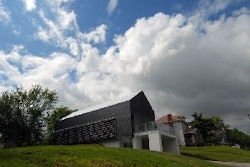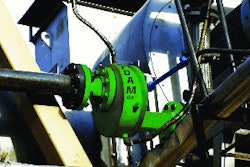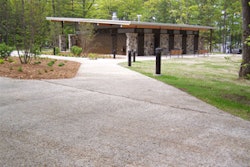About 10 years ago, Basement Contractors of Oklahoma, Edmond, Okla., started building insulated above-grade concrete walls, and over the years has built about 20 homes this way along with a handful of light commercial properties. Owner and president Mike Hancock, P.E., says he has seen the green building market picking up momentum in recent years. "I think it's very important and people are very conscious of this kind of building, but there is still an economic decision people make based on what they want versus what they can afford. Homeowners are not willing to pay for green building features until they can earn their money back somehow," he explains. "An insulated concrete home with thermal mass of the walls maintains the home's environment more steadily than anything else out there, and it's a homeowner's least expensive green building item to invest in to gain the most out of."
"When it comes to the commercial realm," he continues, "commercial owners are starting to say, 'If we're going to build, we might as well build thermally efficient.' They want to minimize their exposure to damage in industrial areas and still have something that's architecturally pleasing. Of course, concrete lends itself to that, whether it be tilt-up, poured-in-place or ICF blocks."
Basement Contractors of Oklahoma's crews are trained in several insulated concrete systems, including Thermomass, ThermaEZE and E-MAXX, which are all used in conjunction with aluminum concrete forms. Crews are also trained on all major brands of ICFs (insulating concrete forms). Hancock looks at a project in the planning stages and decides which system will work best in the building situation.
"I like the Thermomass system when both sides of the wall are going to be exposed so they can be finished on the outside and inside. If there will be brick on the outside, a lot of times we'll use E-MAXX or ThermaEZE and just put foam on the outside of the wall. If there will be sheet rock on the inside and the owner wants a little more sound proofing, we put the foam on the inside and outside. So we use the product that most benefits the customer," he explains.
Hancock adds that his company also utilizes insulating concrete forms (ICFs) in situations where those products ease construction, such as a one-sided pour, against a bank or against another wall on a remodel.
When building for energy efficiency, Hancock looks at how to best take advantage of concrete's thermal properties. Basement Contractors of Oklahoma rarely insulates basement walls, whether it's under a wood frame house or an insulated above-grade concrete walls home. Hancock explains that in southern climates, like Oklahoma, there are more cooling degree days than heating degree days so homeowners benefit more often from utilizing the thermal mass of the 65 degree soil temperature against the basement walls.
"People always teach contractors to insulate the basement, but I really believe that if you look at the numbers it is more energy efficient to not insulate the basement in a southern climate. We insulate to where our temperatures are going to be the highest because the heat transfers from hot to cold. If it's 100 degrees outside, we want to insulate the outside and don't want that heat to transfer into the house. We insulate our walls to keep the heat from coming in but allow the warmer house temperature to leave through the uninsulated basement walls and into the ground."
In addition to energy efficient building, Basement Contractors of Oklahoma utilizes fly ash and blast slag mixes whenever possible, in order to create a green mix using industrial waste as a substitute for cement in the concrete mix.
To read more about Basement Contractors of Oklahoma and some of the company's recent projects, read the full cover story profile of the company in the January 2010 issue of Concrete Contractor magazize.



















